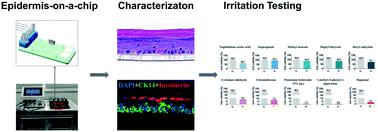Our official English website, www.x-mol.net, welcomes your feedback! (Note: you will need to create a separate account there.)
Construction of a high fidelity epidermis-on-a-chip for scalable in vitro irritation evaluation
Lab on a Chip ( IF 6.1 ) Pub Date : 2021-07-12 , DOI: 10.1039/d1lc00099c Jing Zhang 1, 2 , Zaozao Chen 1, 2 , Yaoyao Zhang 2 , Xingchi Wang 2 , Jun Ouyang 2 , Jianfeng Zhu 2 , Yuchuan Yan 2 , Xiaowei Sun 2 , Fei Wang 2 , Xiaoran Li 2 , Huan Ye 2 , Shiqi Sun 2 , Qingdong Yu 2 , Jiawei Sun 2 , Jianjun Ge 2 , Qiwei Li 1 , Qianqian Han 3 , Yuepu Pu 4 , Zhongze Gu 1, 2
Lab on a Chip ( IF 6.1 ) Pub Date : 2021-07-12 , DOI: 10.1039/d1lc00099c Jing Zhang 1, 2 , Zaozao Chen 1, 2 , Yaoyao Zhang 2 , Xingchi Wang 2 , Jun Ouyang 2 , Jianfeng Zhu 2 , Yuchuan Yan 2 , Xiaowei Sun 2 , Fei Wang 2 , Xiaoran Li 2 , Huan Ye 2 , Shiqi Sun 2 , Qingdong Yu 2 , Jiawei Sun 2 , Jianjun Ge 2 , Qiwei Li 1 , Qianqian Han 3 , Yuepu Pu 4 , Zhongze Gu 1, 2
Affiliation

|
3D skin equivalents have been increasingly used in the pharmaceutical and cosmetic industries, but the troublesome operation procedure and low throughput restricted their applications as in vitro safety evaluation models. Organ-on-a-chip, an emerging powerful tool in tissue/organ modeling, could be utilized to improve the function of the skin model compared with that of traditional static skin models, as well as innovate an automatic and modular way for construction or detection. In this research, we grew and differentiated human keratinocytes within a microfluidic chip to construct an integrated epidermis-on-a-chip (iEOC) system, which is specially designed to integrate multi-culture units with integrated bubble removal structures as well as trans-epithelial electrical resistance (TEER) electrodes for barrier function detection in situ. After 14 days of culture at the air–liquid interface (ALI), the constructed epidermis-on-a-chip demonstrated histological features similar to those observed in normal human epidermis: a proliferating basal layer and differentiating spinous, granular, and cornified layers, especially the TEER value reached 3 kΩ cm2 and prevented more than 99% of Cascade Blue-607 Da permeation owing to the enhanced barrier function. Further immunofluorescence analysis also indicated typical keratin expression including keratin-14, keratin-10, loricrin, involucrin, and filaggrin. With the TEER monitoring integration in the chip, it could be convenient for scale-up high-quality epidermis-on-chip fabrication and correlated investigation. Additionally, the iEOC can distinguish all the 10 known toxins and non-toxins in irritation measurement by MTT assay, which is consistent with animal testing according to the OECD. Preliminarily detection of irritation responses like inflammatory cytokines also predicted different irritation reactions. This high fidelity epidermis-on-a-chip could be a potential alternative in in vitro skin irritation evaluation. This microchip and automated microfluidic systems also pave the way for scalable testing in multidisciplinary industrial applications.
中文翻译:

用于可扩展的体外刺激评估的高保真表皮芯片的构建
3D 皮肤等效物已越来越多地用于制药和化妆品行业,但操作过程繁琐和吞吐量低限制了其在体外的应用安全评价模型。器官芯片是一种新兴的组织/器官建模强大工具,与传统静态皮肤模型相比,可用于改善皮肤模型的功能,并创新一种自动化和模块化的构建或检测。在这项研究中,我们在微流控芯片中培养和分化了人类角质形成细胞,以构建集成表皮芯片 (iEOC) 系统,该系统专门设计用于集成具有集成气泡去除结构的多培养单元以及跨用于原位屏障功能检测的上皮电阻 (TEER) 电极. 在气液界面 (ALI) 培养 14 天后,构建的片上表皮表现出类似于在正常人表皮中观察到的组织学特征:增殖的基底层和分化的棘层、颗粒层和角化层,特别是 TEER 值达到了 3 kΩ cm 2由于增强的屏障功能,阻止了超过 99% 的 Cascade Blue-607 Da 渗透。进一步的免疫荧光分析还表明了典型的角蛋白表达,包括角蛋白 14、角蛋白 10、loricrin、外皮蛋白和丝聚蛋白。通过芯片中的 TEER 监测集成,可以方便地放大高质量的芯片上表皮制造和相关研究。此外,iEOC 可以通过 MTT 法在刺激性测量中区分所有 10 种已知毒素和非毒素,这与 OECD 的动物测试一致。对炎症细胞因子等刺激反应的初步检测也预测了不同的刺激反应。这种高保真芯片上的表皮可能是体外的潜在替代品皮肤刺激评估。这种微芯片和自动化微流体系统也为多学科工业应用中的可扩展测试铺平了道路。
更新日期:2021-08-19
中文翻译:

用于可扩展的体外刺激评估的高保真表皮芯片的构建
3D 皮肤等效物已越来越多地用于制药和化妆品行业,但操作过程繁琐和吞吐量低限制了其在体外的应用安全评价模型。器官芯片是一种新兴的组织/器官建模强大工具,与传统静态皮肤模型相比,可用于改善皮肤模型的功能,并创新一种自动化和模块化的构建或检测。在这项研究中,我们在微流控芯片中培养和分化了人类角质形成细胞,以构建集成表皮芯片 (iEOC) 系统,该系统专门设计用于集成具有集成气泡去除结构的多培养单元以及跨用于原位屏障功能检测的上皮电阻 (TEER) 电极. 在气液界面 (ALI) 培养 14 天后,构建的片上表皮表现出类似于在正常人表皮中观察到的组织学特征:增殖的基底层和分化的棘层、颗粒层和角化层,特别是 TEER 值达到了 3 kΩ cm 2由于增强的屏障功能,阻止了超过 99% 的 Cascade Blue-607 Da 渗透。进一步的免疫荧光分析还表明了典型的角蛋白表达,包括角蛋白 14、角蛋白 10、loricrin、外皮蛋白和丝聚蛋白。通过芯片中的 TEER 监测集成,可以方便地放大高质量的芯片上表皮制造和相关研究。此外,iEOC 可以通过 MTT 法在刺激性测量中区分所有 10 种已知毒素和非毒素,这与 OECD 的动物测试一致。对炎症细胞因子等刺激反应的初步检测也预测了不同的刺激反应。这种高保真芯片上的表皮可能是体外的潜在替代品皮肤刺激评估。这种微芯片和自动化微流体系统也为多学科工业应用中的可扩展测试铺平了道路。



























 京公网安备 11010802027423号
京公网安备 11010802027423号